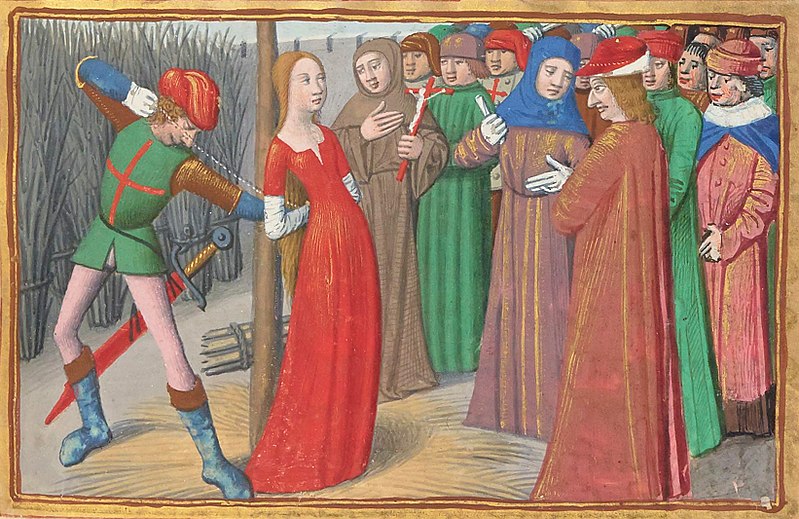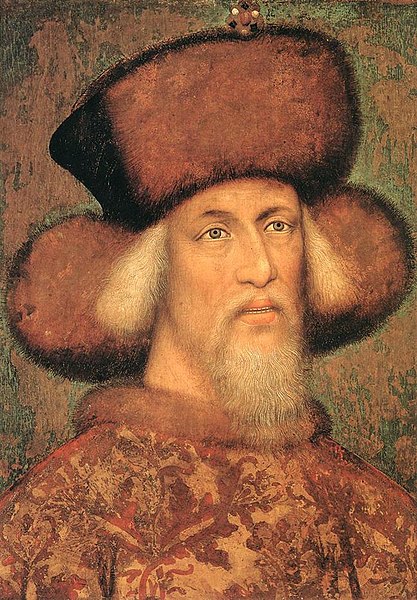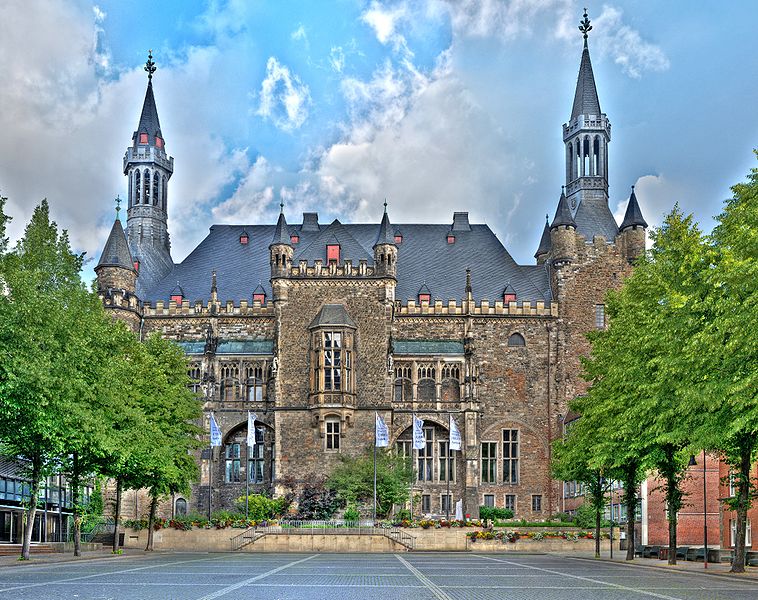 |
| John of Luxembourg |
Capturing the Maid
It was at
Compiègne that, during the fighting, Joan was surrounded by Burgundian
soldiers. The Burgundian chronicler Georges Chastellain recorded that;
‘An archer….dragged her
[Joan] to one side by her cloth-of-gold cloak and pulled her from her horse,
throwing her flat on the ground; never could she find succour or recourse in
her men, try thought they might to remount her.’[i]
Joan
surrendered to one of Philip’s nobles. The theologians of the University of Paris were eager to try her for her
dubious claims of receiving instructions direct from God. They first wrote to
Philip requesting that he hand over his prisoner and Philip and his subordinate
John of Luxembourg, went to meet with Joan at Beauvoir, where she
was imprisoned, on June 6th. Philip was;
‘More delighted than if a
king had fallen into his hands.’[ii]
 |
| Joan of Arc at the stake |
The results
of the interview were not publicised, but, as Joan had not been handed over to
them, the theologians sent Pierre Cauchon[iii], the Bishop of Beauvais, to press their case. Cauchon was
able to extract Joan from the Burgundians and on 14th July he
presented a summons for Joan to be handed over to the Inquisition. A ransom of 10,000 livres was offered[iv] to be paid by the English
treasury.
Joan’s trial
started on 9th January 1431; after Joan repented her sins Cauchon
was forced into chicanery to please the English who had no intention of
allowing Joan to evade being burnt at the stake as a heretic. She was found
guilty of lying about her claims to be following the adjurations of St Catherine and St Margaret. She was burnt at the stake in Rouen on 30th May 1431.
Ending the Truce
Once Joan
was dead, Charles VII, self-proclaimed king of France, followed the maid’s
advice and cancelled the truces arranged with Philip. In response Philip gathered his troops for a winter
campaign.
The timing
was not good; Flanders was suffering from a dearth of trade as England refused
to buy good Flemish wool for their weavers and were reluctant to ship their
trade goods through Burgundian lands. The weavers objected strongly to Philip’s
monetary policies which placed the tradesmen under the authority of their
guilds and aggravated the trade situation. Seigneur Roubaix begged Philip to
forgive the weavers;
‘Or we and the other poor
ducal officers living in Ghent will be on the way to total perdition of lives
and goods.’[v]
Philip
listened to his adviser and pardoned the weavers, but the troubles were not
just focussed in Ghent and were to cause problems for Philip for years to come.
 |
| Chappes |
Throughout
1430-1 Charles VII’s troops had been attacking Burgundian lands. One French
captain invaded the north of the duchy in January, retreating in March. In
August Charolais was attacked; in the autumn the French attacked Philip’s
northern domains again in the region around Auxerre and Tonnere. In December the
Burgundians lost a battle at Chappes in December, losing much of their artillery.
In the
spring of 1431 Philip’s brother-in-law Charles of Bourbon led troops back into
Charolais. In June Philips’ troops redeemed themselves with a victory at Bulgnéville[vi], following a Burgundian chevauchée into Lorraine on behalf of Philip’s ally Antoine de Vaudémont. By September, the truces protecting
Burgundy were back in place, following the conference at Bourg-en-Bresse.
Stirring up Trouble
 |
| Frederick of Austria |
Charles VII was
unable to follow up on any of his minor victories as his court was weak and his
favourite Georges de la Trémoille was too busy fighting potential
rivals for the king’s favour. Instead Charles instigated a proxy war with the Duke of Austria Frederick IV attacking Philip’s lands on Charles’
behalf.
Frederick
does not seem to have been fully committed to all-out warfare as he only
instigated a few border raids. One of Philip’s captains managed to seize the
border fortress of Belfort at Ferrette[vii]. Philip had taken the precaution of
arming himself with truces with the Archbishop Elector of Cologne and the Bishop of Strasbourg. By October an Austro-Burgundian
peace treaty had been agreed and was reinforced the following may by a six year
treaty.
George de la
Trémoille planned to kidnap the Burgundian chancellor Nicolas Rolin in an
attempt to bring Philip to heel. Rolin twice missed being taken by Trémoille’s
men. By now the French were working on influencing Philip’s counsellors and
one
of them, Jehan de la Trémoille, was George’s brother. Two of
Philips’ lords renounced their allegiance; Louis de Chalon, Prince of Orange, and Guillaume de Châteauvillain who attacked Burgundy’s borders on
behalf of Charles VII
 |
| Jehan de la Tremoille |
The
campaigns of 1433 and 1434 were successful in seeing off the enemy. Philip led
his troops in the 1433 fighting season, which saw him regain many of his losses
around Auxerre. The campaign cost Philip 150,000 francs[viii]. In 1434 the new Duke of Bourbon joined in the attacks on Burgundy. .
At the end
of the summer of 1434 Châteauvillain’s principal stronghold at Grancey, near Langres, surrendered. In the autumn Philip cleared Charolais of his brother-in-law’s
troops and then carried the war into Beaujolais. Bourbon was forced to sue for peace
and in January 1435 Châteauvillain’s final refuge fell through treachery.
Enter, the Holy Roman Emperor, Stage Right
 |
| Emperor Sigismund |
Towards the
end of 1434, at the beginning of an exceptionally cold winter[ix] the Holy Roman Emperor Sigismund
declared Reichskrieg on
Burgundy. Sigismund had watched indignantly while Philip brought some of the
wealthiest lands in the Holy Roman Empire under his control. Caught up in
fighting the Hussites in Bohemia meant that Sigismund had been unable to do anything about
Philip’s appropriations until now, especially as he had needed Philip’s
assistance to deal with the Hussites. Sigismund was particularly concerned
about the return of Brabant.
On 8th
May 1434 Sigismund and Charles VII signed a treaty against Philip; Sigismund
promised to declare war on Philip within six months, while Charles was to
continue harassing Philip’s lands. Sigismund also tried to involve the Council of Basle[x], the Duke of Savoy and the Prince-Bishop of Liège in his war against his erstwhile
ally. The Council was unimpressed by Sigismund’s attempts at cajolery.
‘[We] offer ourselves as
mediators, urging your imperial benignity and clemency, to give up and desist
in this matter….We have written to this effect to aforesaid illustrious lord
[Philip].’[xi]
Having
declared war under the terms of his treaty with Charles VII, Sigismund found
himself without an army. The imperial princes refused to provide the necessary
fighters and Sigismund had to content himself with circulating anti-Burgundian
manifestos to which Philip replied in kind. Philip had the declaration of war
circulated to anyone in the Empire who mattered. He enclosed copies of his own
letters asking for assurances for the safety of Burgundian merchants, appealing
to the self-interest of the readers.
 |
| Aachen city hall |
Sigismund
did not campaign against Burgundy in the spring of 1435; lacking support from
his electors. The principal cities and towns of his realm, Frankfurt, Nüremberg, and others responded positively to
Philip’s request that his merchants be kept safe. In May 1435 Sigismund
gratefully accepted the Council of Basle’s offer to conciliate between the two
parties.
Sigismund
then tried to persuade his vassals individually to attack Philip and in July
1437 empowered Louis, the Landgrave of Hesse to recover those imperial lands lost
to Philip. At a meeting in Aachen Louis tried to persuade the
Brabantians and Hainaulters to accept him as their rightful ruler but they sent
copies of Louis’ declarations to Philip. When Louis arrived in Limburg with an army he was driven back to Aachen. Louis returned to Hesse;
further incursions died a death along with Sigismund who died in the December.
Bibliography
The Hundred
Years War – Alfred Burne, Folio Society 2005
The Reign of
Henry VI – RA Griffiths, Sutton Publishing Ltd 1998
The Holy
Roman Empire – Friedrich Heer, Phoenix Giant 1995
Europe:
Hierarchy and Revolt 1320-1450 – George Holmes, Fontana 1984
The
Fifteenth Century – EF Jacob, Oxford University Press 1997
Isabel of
Burgundy – Aline S Taylor, Madison Books 2001
Philip the
Good – Richard Vaughan, Boydell Press 2014
The
Hapsburgs – Andrew Wheatcroft, the Folio Society 2004
www.wikipedia.en
[i]
The Maid and the Queen - Goldstone
[ii]
Isabel of Burgundy - Taylor
[iii]
Cauchon had been an apologist for the Burgundian alliance with England,
throwing his support behind Philip. He had been instrumental in the drawing up
of the Treaty of Troyes
[iv]
In 2015
the relative: historic standard of living value of that income or wealth is £6,250,000.00 labour earnings of that income or wealth is £59,970,000.00 economic status value of that income or wealth is £191,200,000.00 economic power value of that income or wealth is £3,395,000,000.00 www.measuringworth.com
[v]
Isabel of Burgundy - Taylor
[vi]
Fought over the partitioning of Lorraine; the loser was René of Anjou, who
was taken prisoner by Philip’s men
[vii]
Formerly part of Burgundian territory, Ferrette formed part of the dowry of
Philip’s aunt Catherine
of Burgundy who married Leopold IV of
Austria
[viii]
In 2015 the relative: labour cost of that project is £300,600,000.00 economic cost of that project is £18,630,000,000.00 www.measuringworth.com
[ix]
The River Thames froze
along with most of the Thames estuary and ships had to unload at Sandwich. In Arras the
civic authorities recorded all the snow men set up in the streets; they
included representations of the Danse Macabre, the Seven Sleepers and Joan
of Arc.
[x]
Also known as the Council of Florence; the council had come to an agreement
with the Hussites
[xi]
Philip the Good - Vaughan
No comments:
Post a Comment
Note: only a member of this blog may post a comment.